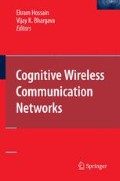Access this chapter
Tax calculation will be finalised at checkout
Purchases are for personal use only
Preview
Unable to display preview. Download preview PDF.
References
R. W. Broderson, A. Wolisz, D. Cabric, S. M. Mishra, and D. Willkomm, “CORVUS: A cognitive radio approach for usage of virtual unlicensed spectrum,” White Paper submitted at the University of Berkeley, CA, July. 2004.
Federal Communications Commission, “Spectrum Policy Task Force,” Report ET Docket no. 02-135, Nov. 2002.
J. Mitola, “The software radio architecture,” IEEE Commun. Mag., vol. 33, no. 5, pp. 26–38, May 1995.
J. Mitola III, “Cognitive radio for flexible mobile multimedia communications,” in Proc. 6th International Workshop on Mobile Multimedia Commun. (MoMuC’99) (San Diego, CA), pp. 310, Nov. 1999.
J. Mitola III and G. Q. Maguire Jr., “Cognitive radios: Making software radios more personal,” IEEE Pers. Commun. Mag., vol. 6, pp. 13–18, Aug. 1999.
S. Haykin, “Cognitive radio: Brain-empowered wireless communications,” IEEE J. Select. Areas Commun., vol. 23, no. 2, pp. 201–220, Feb. 2005.
D. Cabric, S. M. Mishra, and R. W. Brodersen, “Implementation issues in spectrum sensing for cognitive radios,” in Proc. Asilomar Conf. on Signals, Systems, and Computers (Pacific Grove, CA), pp. 772–776, Nov. 2004.
S. M. Mishra, A. Sahai, and R. Brodersen, “Cooperative sensing among cognitive radios,” in Proc. IEEE Int. Conf. Commun. (ICC’06) (Istanbul, Turkey), June 2006.
T. Weiss and F. K. Jondral, “Spectrum pooling: An innovative strategy for the enhancement of spectrum efficiency,” IEEE Commun. Mag., vol. 43, no. 3, pp. S8–S14, Mar. 2004.
I. F. Akyildiz, W. Y. Lee, M. C. Vuran, and S. Mohanty, “NeXt generation/dynamic spectrum access/cognitive radio wireless networks: A survey,” Comput Netw (Elsevier), vol. 50, pp. 2127–2159, Sept. 2006.
Darpa XG Working group, “The xg architectural framework,” rfc v1.0 2003.
Darpa XG Working group, “The xg vision,” rfc v1.0 2003.
C. Cordeiro, K. Challapali, D. Birru, and S. Shankar, “IEEE 802.22: The first worldwide wireless standard based on cognitive radios,” in Proc. IEEE Int. Symposium on Dynamic Spectrum Access Networks (DySPAN’05), pp. 328–337, Nov. 2005.
M. M. Buddhikot, P. Kolody, S. Miller, K. Ryan, and J. Evans, “DIMSUMNet: New directions in wireless networking using coordinated dynamic spectrum access,” in Proc. IEEE Int. Symposium on a World of Wireless, Mobile and Multimedia Networks (WoWMoM’ 05), pp. 78–85, June 2005.
I. F. Akyildiz and Y. Li, “OCRA: OFDM-based cognitive radio networks,” Technical report, Broadband and Wireless Networking Laboratory, Georgia Institute of Technology, Mar. 2006.
L. Xu, R. Tonjes, T. Paila, W. Hansmann, M. Frank, and M. Albrecht, “DRiVE-ing to the internet: Dynamic radio for IP services in vehicular environments,” in Proc. 25th Annual IEEE Conference on Local Computer Networks, pp. 281–289, Nov. 2000.
T. Weiss, J. Hillenbrand, A. Krohn, and F. K. Jondral, “Mutual interference in OFDM-based spectrum pooling systems, ” in Proc. IEEE Vehicular Technol. Conf. (VTC’04), vol. 4, pp. 1873–1877, May 2004.
T. Keller and L. Hanzo, “Multicarrier modulation: A convenient framework for time-frequency processing in wireless communications,” Proc. IEEE, vol. 88, no. 5, pp. 611–640, May 2000.
A. T. Toyserkani, J. Ayan, S. Naik, Y. Made, and O. Al-Askary, “Sub-carrier based adaptive modulation in HIPERLAN/2 system,” in Proc. IEEE Int. Conf. Commun. (Paris, France), pp. 3460–3464, June 2004.
L. Goldfeld and V. Lyandres, “Capacity of the multicarrier channel with frequency-selective Nakagami fading,” IEICE Trans. Commun., vol. E83-B, no. 3, pp. 697–702, Mar. 2000.
C. Y. Wong, R. S. Cheng, K. B. Letaief, and R. D. Murch, “Multiuser OFDM with adaptive subcarrier, bit, power, and power allocation,” IEEE J. Select. Areas Commun., vol. 17, no. 10, pp. 1747–1758, Oct. 1999.
A. M. Wyglinski, “Effects of bit allocation on non-contiguous multicarrier-based cognitive radio transceivers,” in Proc. 64th IEEE Veh. Technol. Conf. – Fall (Montreal, Canada), Sept. 2006.
J. M. Cioffi, “A multicarrier primer,” ANSI T1E1.4 Committee Contribution, pp. 91–157, Nov. 1991.
A. Antonio and W.-S. Lu, Optimization methods, algorithms, and applications. Kluwer Academic, 2005.
P. Chow, J. Cioffi, and J. Bingham, “A practical discrete multitone transceiver loading algorithm for data transmission over spectrally shaped channels,” IEEE Trans. Commun., vol. 43, no. 2/3/4, pp. 773–775, Feb./Mar./Apr.yy1995.
S. T. Chung and A. J. Goldsmith, “ Degrees of freedom in adaptive modulation: A unified view, ” IEEE Trans. Commun., vol. 49, no. 9, pp. 1561–1571, Sept. 2001.
J. Bingham, “Multicarrier modulation for data transmission: An idea whose time has come,” IEEE Commun. Mag., vol. 28, no. 5, pp. 5–14, May 1990.
Author information
Authors and Affiliations
Editor information
Editors and Affiliations
Rights and permissions
Copyright information
© 2007 Springer Science+Business Media, LLC
About this chapter
Cite this chapter
Bansal, G., Hossain, M.J., Bhargava, V.K. (2007). Link Adaptation in OFDM-Based Cognitive Radio Systems. In: Hossain, E., Bhargava, V. (eds) Cognitive Wireless Communication Networks. Springer, Boston, MA. https://doi.org/10.1007/978-0-387-68832-9_7
Download citation
DOI: https://doi.org/10.1007/978-0-387-68832-9_7
Publisher Name: Springer, Boston, MA
Print ISBN: 978-0-387-68830-5
Online ISBN: 978-0-387-68832-9
eBook Packages: EngineeringEngineering (R0)

